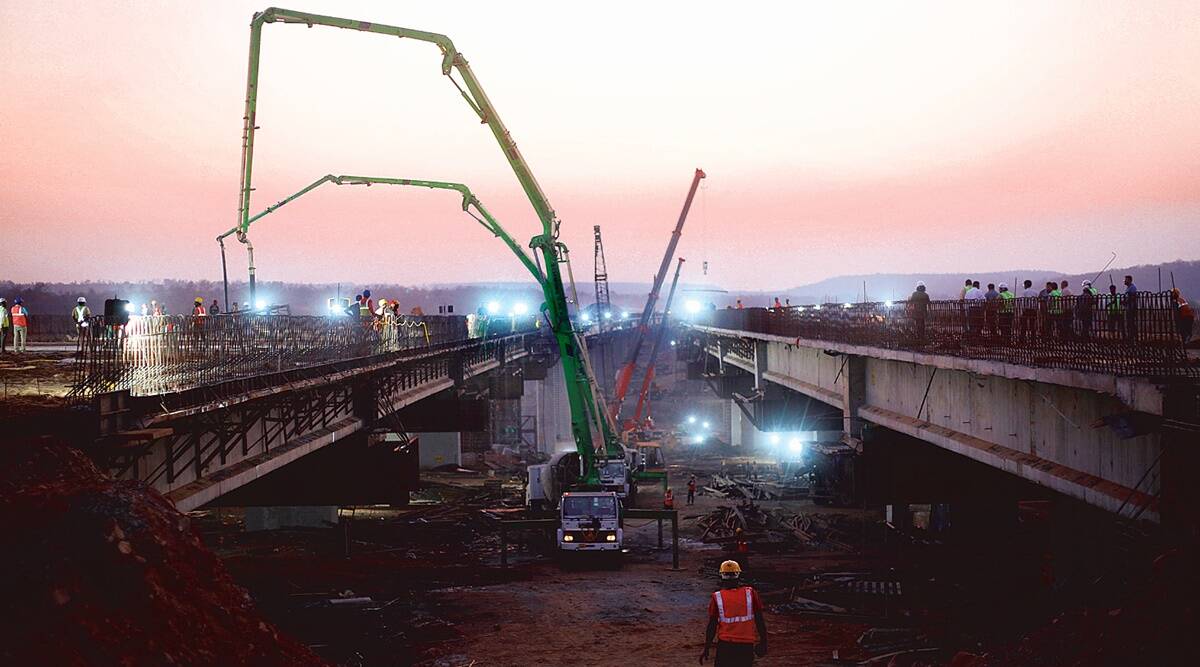Slamming the brakes as a deer darts across the road or waiting patiently as a herd of animals crosses it at a leisurely pace are common experiences of driving on roads cutting through forested areas.
But on India’s fastest highway — the under-construction Nagpur-Mumbai Super Communication Expressway, which is designed for a top speed of 150 kmph — the focus is on co-existence, with five “wildlife bridges” and a network of underpasses being built.
The 701-km-long and 120-m-broad highway, which will be partly commissioned this May, cuts across three sanctuaries — Tansa (Thane), Katepurna (Akola-Washim border) and Karanja-Sohol (Washim) — and 35 wildlife focus areas (WFAs) – 16 in Vidharbha, 16 in the North Western Ghats, 3 in Marathwada — stretched over 118 km across the route. And there is a lot more at stake than a roadkill.
A high-speed corridor cutting across wildlife habitat can severely restrict the movement of animals, altering their behaviour and dispersal patterns. Mindful of this, the Maharashtra State Road Development Corporation (MSRDC), that is building the highway, joined forces with the Wildlife Institute of India (WII) to engineer safe wildlife crossings.
“The idea is to give native animals a way to get across the road without endangering themselves… The good thing about this highway is that it is the first one where wildlife mitigation has been considered, even as it does not cut across any of the protected areas of a forest. We wanted to set an example,” said Dr Bilal Habib, WII scientist who was the project’s lead investigator for wildlife mitigation measures.
While animal underpasses are not new, the five “wildlife bridges” — three overpasses in the wildlife focus areas of the project in Vidarbha and two in the highlands of Aurangabad — are the first of their kind in India, he said.
While the National Highways Authority of India (NHAI) has also announced a plan to construct animal bridges along the proposed Delhi-Mumbai expressway, the land acquisition process for this corridor is still in progress. On the other hand, work on the Nagpur-Mumbai corridor is almost 70 per cent complete.
We are proud to announce that Jharkhand CM @HemantSorenJMM will be the Chief Guest of the discussion ‘Decoding India’s internal migration’ on February 12 at 2pm.
Register here to join: https://t.co/ngDRKfgS9T pic.twitter.com/7DLIk0HZju
— The Indian Express (@IndianExpress) February 9, 2021
Maharashtra Chief Minister Uddhav Thackeray, who has named the project after his father Bal Thackeray, has announced that a 502-km stretch along the route — connecting Nagpur to Shirdi — will be opened to the public on May 1. MSRDC’s Vice Chairman-cum-Managing Director Radheshyam Mopalwar said the remaining section of the corridor will be commissioned on or before May next year.
Racing to meet the first deadline, civil contractors engaged by the MSRDC are designing a straight-edged parabolic-approach ramp-way for a 60-m wide wildlife overpass along the route in Wardha. “The basic structure will be ready within three months,” said B K Jha, the site’s project manager. Dr Habib said a parabolic approach will help to guide the wildlife to the bridge.
This stretch of the highway is located in the middle of a functional corridor between the Bor Tiger Reserve and the Umred-Karhandla Wildlife Sanctuary.
Besides tigers, the area is also home to the nilgai, sambar, chinkara, wild boar, Indian hare, porcupine, striped hyena and golden jackal. “Fragmentation of such patches can lead to destruction of habitat, and also affect the animal density and movement,” the WII had said in a report which advocated the overpass to avoid a man-animal conflict.
The wildlife bridge will also be covered with native flora. “The art is to make it look as natural as possible. An animal should be happy to use the crossing,” said Dr Habib.
“Once the civil work is over, we’ll engage specialised landscaping agencies for the job,” said Bhushan Malkhandale, MSRDC’s executive engineer.
Just 6 km ahead, another 45-m wide “wildlife bridge” is being built. Also, there are undercrossings – viaducts, underpasses, and box culverts — designed to cater to wildlife. “We have planned 80 structures along the route to cater to animal movement,” said Mopalwar.
Based on WII’s inputs, the MSRDC has increased the height of all box culverts, being built within a 10-km buffer area of a wildlife habitat, to 4-5 metres to facilitate movement of smaller animals . “For all wildlife structures, the median will be left open for proper light and ventilation. All viaducts, major and minor bridges, overpasses and underpasses will have noise barriers and landscaping suitable for wildlife,” said Mopalwar.
Towards the Katepurna Wildlife Sanctuary, on the Washim-Akola border, about 214 km from the corridor’s starting point, work on construction of a 190-m wide viaduct cutting across the sanctuary is underway.
“To facilitate movement of large mammals in groups beneath the highway, we’ve increased the height and widened the bridge,” said Rajendra Malwat, executive engineer and manager, MSRDC. Those working at the site said they had spotted herds of deer and nilgai.
Nearby, an overpass and a culvert are being built. Since the site is close to the protected area of the sanctuary, the use of heavy machinery has been barred. The noise barriers will come up after the construction is completed, said Malwat.
During its field surveys, the WII reported 25 different species along the route. While the nilgai, chinkara and jungle cat were among the most common, the Indian pangolin, honey badger and barking deer were also sighted.
“We studied the land use classes in these regions to see how wildlife species were utilising them before recommending specific mitigation measures,” said Dr Habib. In the coming months, his team is also planning to document the flight path of birds along the route.
This article is auto-generated by Algorithm Source: indianexpress.com


